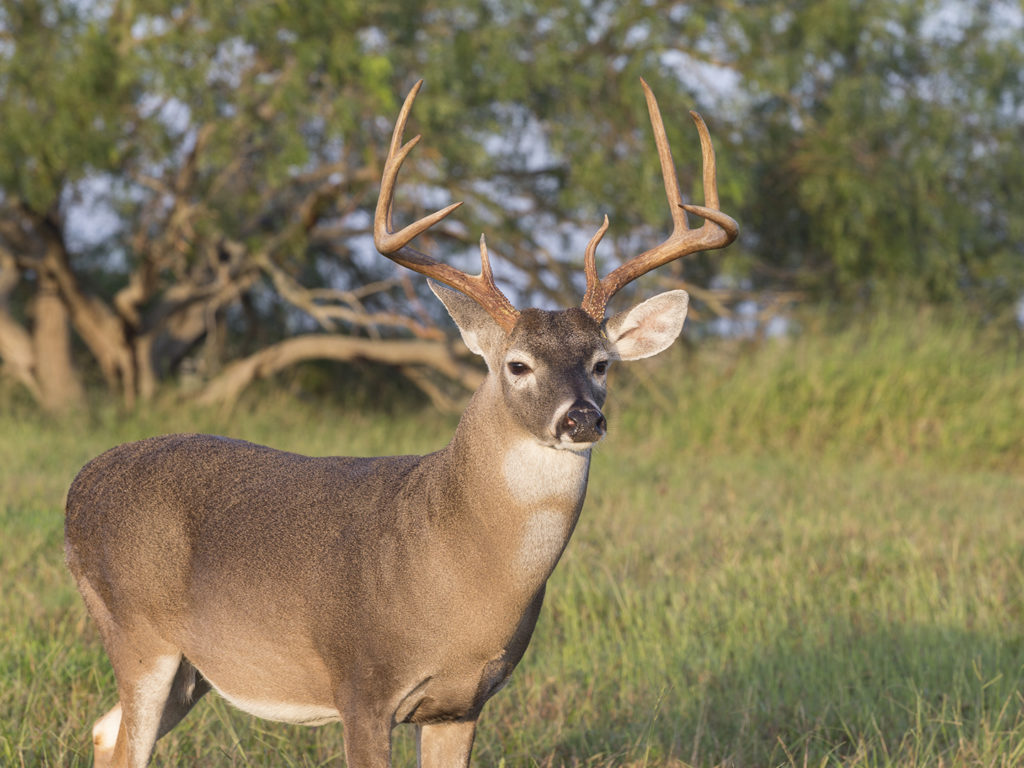New Study Indicates Captive Texas Deer Can Contract, Likely Transmit SARS-CoV-2 Virus To Each Other
Story by Paul Schattenberg, College of Agriculture and Life Sciences

The research team, led by CVMBS associate professor of epidemiology Dr. Sarah Hamer, has been investigating how animals are involved in the transmission of SARS-CoV-2 since early days of the pandemic in summer 2020. Their initial work detailed infections in about a quarter of the dogs and cats that lived in households with infected owners in Central Texas and led to questions about other animals that interact with humans.
Additionally, work conducted last year by the U.S. Department of Agriculture’s Animal and Plant Health Inspection Service, APHIS, showed free-ranging white-tailed deer populations across Illinois, Michigan, New York and Pennsylvania had produced SARS-CoV-2 antibodies, which indicated they had been exposed to COVID.
The research team then developed collaborations for a study on captive white-tail deer in Texas, focused on animal health and the potential for viral transmission from infected animals to other animals.
Hamer, principal investigator for the new study, said since free-ranging white-tailed deer with evidence of SARS-CoV-2 infection have been found in several states, now including Texas, it was important to understand how the risk to captive deer may be similar or different.
“These studies open our eyes to a less ‘human-centric’ perspective on COVID transmission and to the need to investigate potential animal reservoirs for the disease,” she said.
Specifics Of The Study
White-tailed deer have been shown to be susceptible to SARS-CoV-2 because their ACE2, or angiotensin converting enzyme 2, which is where the virus attaches, is very similar to that of humans, said Dr. Terry Hensley, assistant agency director for diagnostic services with the Texas A&M Veterinary Medical Diagnostic Laboratory (TVMDL), Bryan-College Station.
“However, while the white-tailed deer in the USDA study were able to be infected with SARS- CoV-2, then shed the virus and infect other deer in the study, they did not develop any observable clinical illness from the virus,” he said. “We still have a lot to learn concerning SARS-CoV-2 and wildlife.”
The Texas A&M study, which involved graduate student, postdoctoral, faculty and veterinarian researchers, involved the use of plaque reduction neutralization assays to test for SARS-CoV-2 antibodies in 80 deer at three captive cervid facilities in Central and South Texas, and additional work is ongoing.
Samples were tested in a TVMDL Biosafety Level 3 laboratory.
“The level of infection we detected, which was more than 90% of the tested captive deer at one facility, cannot be explained by human contact alone,” said Hamer, who also oversees a research laboratory focused on the ecology, evolution and epidemiology of vector-borne wildlife and zoonotic diseases using field-based studies and molecular tools.
“Only a subset of the deer that tested seropositive had close or direct contact with humans,” she explained. “While there may have been some initial human-to-deer transmission of the virus, the vast majority of transmission at that facility appears to have been from deer to deer.”
Hamer also noted the prevalence of COVID-positive deer in the one Texas facility was more than double the amount reported in recent studies of wild deer populations in Texas and some northern states.
The Research And Its Benefits
The study will help researchers better understand the interaction between humans and wild and/or managed animals and the virus, Hamer said. She added that study results may be especially applicable in facilities where wildlife is actively managed and fed through human contact.
“This information could be useful not only to captive cervid facilities, but also zoos and other locations where animals are in close contact with humans and are at a much closer distance from one another than what would be normal for them in the wild,” Hamer said. “It’s also important that we understand transmission among captive cervids and other managed animals so we can get a better picture of their role in the occurrence of SARS-CoV-2.”
Other Insights From The Study
The study confirmed white-tailed deer typically do not get symptoms of SARS-CoV-2 but are easily able to contract and transmit the disease, said Dr. Walter Cook, a study co-author, wildlife veterinarian, and CVMBS clinical associate professor. Other study co-authors from the college included doctoral students Chase Nunez and Logan Thomas.
Cook said other studies have shown certain wildlife to be susceptible to the virus, and what they learned in the new study could help in better understanding how they may transmit the disease.
Previous studies have shown domestic animals such as dogs and house cats can also contract the SARS-CoV-2 virus as a result of contact with infected humans. Hamer was also principal investigator in a Texas A&M-led study in March of last year that, for the first time worldwide, detected the United Kingdom variant of SARS-CoV-2 in a dog and a cat from the same household in Texas.
The new study will be helpful toward finding out whether there might be onward transmission from infected animals to animals of the same or a different species–or possibly back to people.
Hamer said vaccine manufacturers have already created veterinary vaccines for animals that are being used in some zoo environments to protect animals shown to develop disease when infected.
“If we find that infection will endanger the life of animals, or if animals can readily spread the virus to humans, then there will be lots of motivation to also consider widespread vaccination of target animals against SARS-CoV-2,” she said. “But this is not the situation, and the most impact right now will be from vaccinating people.”
This story was modified from Paul Schattenberg’s original article examining the research and possible implications for deer hunters.
###
For more information about the Texas A&M College of Veterinary Medicine & Biomedical Sciences, please visit our website at vetmed.tamu.edu or join us on Facebook, Instagram, and Twitter.
Contact Information: Jennifer Gauntt, Director of VMBS Communications, Texas A&M College of Veterinary Medicine & Biomedical Sciences, jgauntt@cvm.tamu.edu, 979-862-4216


